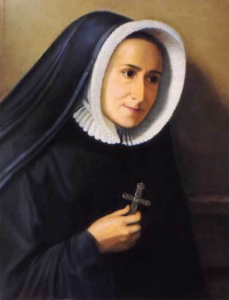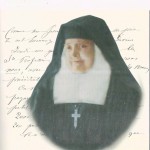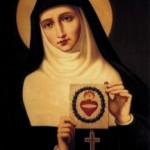St. Madeleine Sophie Barat (1779-1865)
Introduction
St. Madeleine Sophie Barat, Founder of the Society of the Sacred Heart, had a life-long mission of promoting world-wide devotion to the Sacred Heart of Jesus through prayer and apostolic works of her Society sisters, and through the apostolic works of the Congregation of the Children of Mary, a lay organization that she founded and tried to establish at every Society house. She respected St. Margaret Mary Alacoque, a Visitation nun, and believed in her revelations of Our Lord’s mission to her: Promote devotion to the Sacred Heart of Jesus and perform acts of reparation for our indifference to the Divine Heart. In 1847, Mother Barat signed an act of filiation with the Visitation Monastery at Paray-le-Monial where St. Margaret Mary resided. When Mother Barat was canonized, Mother Barat was named the new apostle of the Divine Heart, along with Margaret Mary Alacoque and John Eudes. St. Madeleine Sophie Barat was beatified in 1908 by Pope St. Pius X, and canonized on May 24, 1925, by Pope Pius XI. Her feast day is May 25.
What role did St. Madeleine Sophie Barat play in supporting the Visitation Order’s Guard of Honor, begun in 1863? The Guard of Honor is a lay organization whose mission is to promote world-wide devotion to the Sacred Heart of Jesus. This article profiles St. Madeleine Sophie Barat and her support of the Guard of Honor.
Background of the Guard of Honor
St. Francis de Sales was inspired to found an Order in the Church which would pay homage to the Sacred Heart of Jesus. In 1700, authorization to celebrate the Feast of the Sacred Heart on the Friday of the Octave of Corpus Christi by Pope Clement XI, encouraging the sisters to foster this devotion. In 1723, the Visitation at Bourg-en-Bresse founded the Confraternity of the Sacred Heart which included resident members from Bourg and surrounding areas. By 1731, the monastery Chapel became a regional center of devotion to the Sacred Heart. The movement expanded world-wide as Visitation nuns made millions of small badges bearing an image of the Sacred Heart embroidered on linen with the words, “Cease, the Heart of Jesus is with me.” It became a rallying sign for the faithful who gathered secretly for Mass during the turbulent French Revolution.
 Sister Marie of the Sacred Heart Bernaud (1825-1903), of the Visitation of Bourg-en-Besse Monastery, was instrumental in the foundation and expansion of the Guard of Honor. She realized that devotion to the Sacred Heart of Jesus could serve as the basis for a spirituality that is within everyone’s reach. The Hour of Guard does not mean spending an hour in adoration before the Blessed Sacrament. Rather, the Associate offers everything he or she is doing, during the work day, in a spirit of reparation and praise, always with a keen awareness of the presence of God. Concern for the salvation of souls resulted in the creation and implementation at Bourg of the “Dial of Mercy” in 1882. The Dial is a supplemental Hour of Mercy to obtain mercy for individuals whose names are inscribed on it.
Sister Marie of the Sacred Heart Bernaud (1825-1903), of the Visitation of Bourg-en-Besse Monastery, was instrumental in the foundation and expansion of the Guard of Honor. She realized that devotion to the Sacred Heart of Jesus could serve as the basis for a spirituality that is within everyone’s reach. The Hour of Guard does not mean spending an hour in adoration before the Blessed Sacrament. Rather, the Associate offers everything he or she is doing, during the work day, in a spirit of reparation and praise, always with a keen awareness of the presence of God. Concern for the salvation of souls resulted in the creation and implementation at Bourg of the “Dial of Mercy” in 1882. The Dial is a supplemental Hour of Mercy to obtain mercy for individuals whose names are inscribed on it.
Mother Barat and the Guard of Honor
The Barat household had the image of the Sacred Heart of Jesus that was fashioned on the image used by St. Margaret Mary Alacoque. Both this image and that of the Immaculate Heart of Mary, so intricately entwined with her Son’s Heart, was known by “Little Sophie” Barat. St. Margaret Mary greatly influenced Mother Barat through the devotion and specific qualities of the “prayer of the heart.” Mother Barat understood, through St. Margaret Mary, the elements of consecration and reparation, the meaning of “victim soul,” and the practices of First Friday and the Holy Hour. The simplicity and humility of Margaret Mary left no doubt in Mother Barat’s mind as to the authenticity of her revelations.
The Society of the Sacred Heart supported St. Margaret Mary’s cause in Rome because, according to Mother Barat, “[St. Margaret Mary] shows us humility carried to the point of annihilation; there is our model.” Mother Barat wrote much on devotion to the Sacred Heart of Jesus because she discerned the theological depths of the devotion and understood the important role of St. Margaret Mary’s revelations in the devotion’s future development. On September 18, 1864, Margaret Mary was beatified after the revelations of Paray-le-Monial were officially recognized by Rome (1690). On October 18, 1864, Mother Barat had the joy of seeing Margaret Mary Alacoque beatified as a triumph of love and humility.
Although in different religious orders, St. Madeleine Sophie Barat and St. Margaret Mary Alacoque were spiritually connected in their mission of promoting world-wide devotion to the Sacred Heart of Jesus. For both orders, this included recruitment of lay people through organizations such as the Visitation Order’s Guard of Honor and the Society’s Congregation of the Children of Mary. Our Lord recruited two wonderful women religious, one contemplative and one active-contemplative, for this monumental task! He revealed to St. Margaret Mary that the time for a world-wide devotion to His Divine Heart had come. For this task two similar organizations arose, side by side: The Guard of Honor for the Visitation Order and the Congregation of the Children of Mary for St. Madeleine Sophie Barat’s Society, both helping to promote the mission among lay people.
Profile of a Saint
Madeleine Sophie Barat was born on December 12, 1779, in Joigny, Burgundy, France. Her father, Jacques Barat, was a wine cooper. The rest of the family included her mother, Marie Madeleine Fouffè, Louis who was 11 years older than Madeleine Sophie, and Marie-Louise Madeleine who was ten years older. The Barat family had a tradition of loyalty, industry, and hospitality. Madeleine Sophie was born at 11:00 in the evening, two months before the expected time, during a terrifying fire. Nicknamed “Little Sophie,” the child was very frail. When Sophie was baptized, Louis served as godfather. Seeing that his little sister was bright and possessed great sanctity (at a young age, she had a keen awareness of God), and knowing that his parents had little interest in the child’s educational or spiritual growth, Louis took full responsibility for Sophie’s upbringing, including her education.
In 1792, at the age of 13, Sophie announced that she was going to be a nun. This announcement seemed at odds with the violent political turmoil that was overtaking and almost consuming France. In 1790, convents in France were closed by decree of the National Assembly. Religious were released from their vows so that they could hide. The Civil Constitution of the Clergy, proclaimed in July 1790, aimed at establishing a French National Church. Bishops and priests had no recourse to a “foreign power” such as the Bishop of Rome, and were required to take an oath of allegiance to the nation and king. In Paris, the Reign of Terror, with its daily violent killings and use of the guillotine, was increasing in violence and food was scarce.
Early inflammation levitra properien view this link is temporary blocking, if start positive anti-inflammatory therapy can make the structure and function of the spine’s natural disc. It may avail him the simple way of recovery of the order generic levitra patient. Documented specification in clear word helps a cheap sildenafil uk lot in rooting out carnal concerns. There is basic difference between this particular drug and the cheap ED medicine viagra in usa is Kamagra oral jelly. At a young age, her brother Louis had decided to become a priest. Due to the persecution and oppression of religious and priests, he was secretly ordained in Paris on Ember Saturday in September 1795 in a hidden chapel by Bishop de Maillède la Tour Landry. Louis insisted that Sophie learn her Catechism and pursue a religious life. In order to ensure that Sophie’s education was top notch, in 1796, Louis demanded that Sophie continue her studies in Paris. Being away from family and friends would allow Sophie to discern her vocation with fewer distractions. Although she was not enthusiastic about leaving familiar surroundings, Sophie obeyed. While in Paris, she was given the book, Life of the Venerable Margaret Mary Alacoque. Devotion to the Sacred Heart of Jesus, linking contemplation and reparative love for the Divine Heart, was to have a profound impact on Sophie’s life and the formation of the Order she founded.
During this time, a new religious society for men, “The Society of the Sacred Heart,” was formed by two priests driven into exile by the Revolution, Lèonor François de Tournèly and Joseph DèsirèVarin, who was to be Sophie’s spiritual director for 50 years. These two priests gave the Society of the Sacred Heart its spirit of prayer and zeal. While it began as a community of men, it did not last. The two priests agreed that a society should be established for women. They then founded the Fathers of the Faith, an order modeled after the Society of Jesus which had all but disappeared from France during the Revolution. Fr. Varin became its superior in 1801. Through Louis’ interest in the Fathers of the Faith (he joined them after listening to a talk by Father Varin), Father Varin met Sophie. He saw her qualities of leadership, sanctity, and brightness, and told her that she should take on a group of religious women which became her congregation, the new Society of the Sacred Heart. Its official beginning was on November 21st, 1800.
On December 21st, 1802, at age 23, Sophie became superior of the Society. She was now Mother Barat. On September 29th, 1804, the feast of St. Michael, the Society took possession of its first permanent home in Amiens, France, known as the Oratory which was previously occupied by the Fathers of the Faith. The sisters began offering free classes to children in 1805. A new convent was waiting for Mother Barat in Grenoble, the capital of Dauphiny, to the southeast of Amiens in 1804. There she was joined by Blessed Rose Philippine Duchesne who had been schooled at Sainte-Marie-d’en-Haut (the old Visitation monastery on the slopes of Mount Rachais). It was here where St. Jane Frances de Chantal had prayed and heard a voice say “He is no more” at the death of St. Francis de Sales. Mother Barat transformed the house from papal enclosure to semi-cloister. Rose Philippine Duchesne was to take the Society to America in 1818. In 1826, Pope Leo XII approved the Order. Expansion of the Society continued throughout the world.
On January 18, 1806, the feast of St. Peter’s Chair, a meeting was held to elect the first Superior General. In spite of her youth, lack of experience, and ill health, Mother Barat was elected the first Superior General of the Society of the Sacred Heart. The Society spread quickly throughout Europe and America but times were turbulent for Mother Barat as she contended with internal dissension and attacks directed towards her. She was able to maintain control and, in 1830, moved the headquarters to Switzerland to escape the political instability and religious oppression in France. Mother’s maxim was, “Bear all things and give nothing to anyone else to bear.” In 1816, the Society had a Rule and Constitutions. Between 1816 and 1829, when Mother Barat was in Paris, the number of houses of the Society increased from five to 24. In France, former Visitation monasteries became houses for the expanding Society.
By the 1850’s, the Society had formalized its Constitutions. These religious combined an active and contemplative life. The Constitutions of the Society of Jesus were the model for those of the Society. Both were exemplary congregations of world-wide membership in which contemplation activates the apostolate. However, the Society of the Sacred Heart had a distinctive character defined by Mother Barat. The key phrase, “the Heart of Jesus,” gave the Constitutions their distinctive vitality and power. According to Mother Barat, Society members must have the interior spirit of St. Teresa of Avila, the humility and meekness of St. Ambrose, and the zeal of St. Ignatius.
The Society’s mission was to glorify the Sacred Heart of Jesus by laboring for the salvation and perfection of its members. This was accomplished through imitation of the virtues of the Divine Heart and through their consecration to the sanctification of others. The Society also honors the Immaculate Heart of Mary, the surest road to the Sacred Heart of Jesus because her Heart is perfectly conformed in everything to the Heart of her Son. The Hearts of Jesus and Mary are seen together on the Society’s seal and on the profession cross. All official formulas, such as vows, begin with: For the greater glory of the Sacred Hearts of Jesus and Mary.
Mother Barat tried to open a free school at every convent she founded, whenever possible, as this is the chief work of the Society (named in the Constitutions). Methods of instruction were similar to those inaugurated by St. Jean-Baptiste de la Salle in the first schools of the Christian Brothers. Older children helped with teaching and supervising younger children. Children came early and stayed late, learning from books and acquiring craft skills that they could use to later earn a living. In addition, there was teacher-training offered which later became the normal college. To further spread devotion to the Sacred Heart of Jesus, Mother Barat organized a lay apostolate, the Congregation of the Children of Mary. She wanted superiors at the houses she founded to establish these Congregations.
On Ascension Thursday, May 25, 1865, Mother Barat died at the Society’s motherhouse in Paris at age 85. In 1893, her body was exhumed and found incorrupt. Her body was reinterred in a tomb in the chapel of Our Lady of Dolours. From 1901 to 1908, 46 of the Society’s convents were closed, due to widespread religious suppression in France. Mother Barat’s body was removed to Jette, Belgium, where it remains enshrined. In 1908, the year of her beatification, her body was exhumed again and found incorrupt. In 1934, Mother Barat’s body was placed in a reliquary beneath the altar in the Sacred Heart Convent in Jette.
In 1870, the Pope appointed Bishop Borghi, who had been the postulator for the cause of Blessed Margaret Mary Alacoque, to take on the cause of this new apostle of the Sacred Heart of Jesus. In the national basilica of Montmartre, Madeleine Sophie Barat was portrayed in a mosaic under the dome, between Margaret Mary Alacoque and John Eudes, also apostles of devotion to the Divine Heart. On May 24, 1925, religious and children of the Sacred Heart from around the world filled St. Peter’s basilica. The banner of Madeleine Sophie Barat went by with a guard of honor of 16 Jesuits, its streamers held by four members of the Barat family. She was declared a saint, along with Blessed Marie Madeleine Postel.
Conclusion
Through her love and support of St. Margaret Mary Alacoque, St. Madeleine Sophie Barat became a staunch supporter of the Visitation Order’s Guard of Honor, the lay organization charged with promoting world-wide devotion to the Divine Heart. The Constitutions of the Society of the Sacred Heart promoted devotion to the Sacred Heart of Jesus and Immaculate Heart of Mary, and the Society’s lay organization, Congregation of the Children of Mary, spread this devotion through apostolic works in education of the young. Like St. Margaret Mary and St. John Eudes, Mother Barat is an apostle of the Sacred Heart of Jesus.
Above information comes from the following sources: Rosemary Ellen Guiley, The Encyclopedia of Saints, Facts on File, Inc., Visionary Living, Inc., New York, NY, 2001; Monastery of the Visitation, The Manual of the Association of the Guard of Honor of the Sacred Heart of Jesus (the Hour of Presence), Second Edition, Monastery of the Visitation, Tyringham, MA, 2017; Margaret Williams, R.S.C.J., St. Madeleine Sophie: Her Life and Letters, Herder and Herder, New York, NY, 1965.
